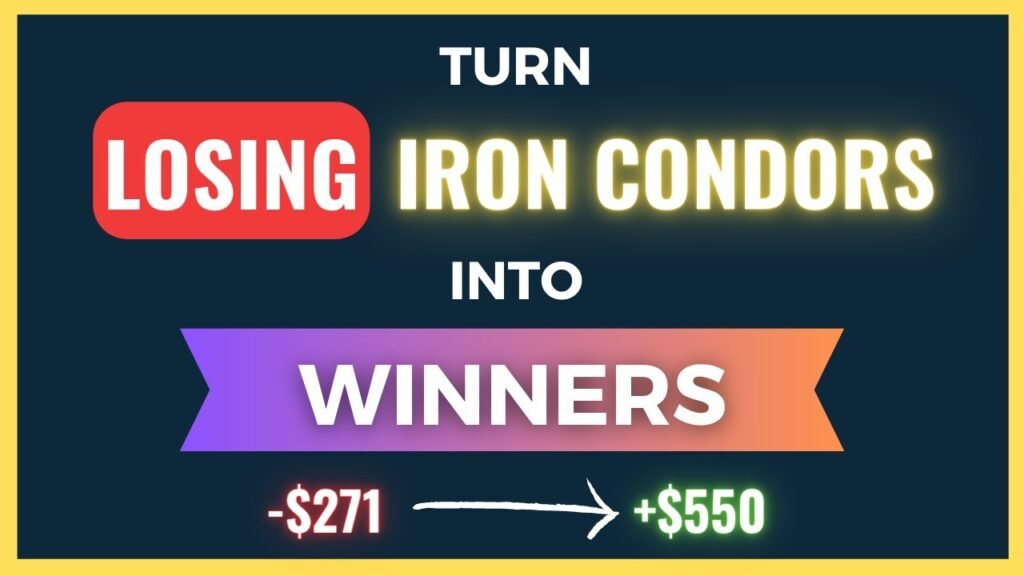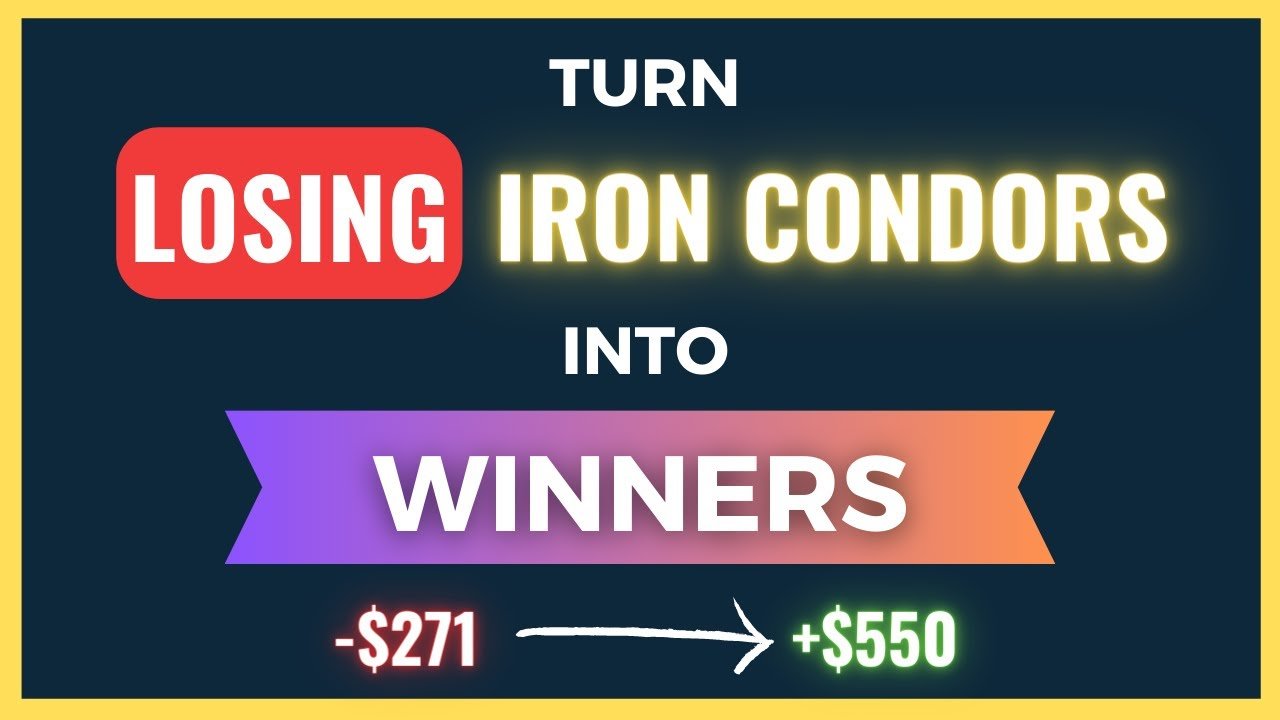Today’s video is all about the Complete Beginner’s Guide to Rolling Iron Condors. In this informative video by Options with Davis, you will learn about the strategy of rolling Iron Condors in options trading. Rolling an Iron Condor is a technique used to adjust and potentially recover from losing trades. The video explains the process of rolling an Iron Condor, including the appropriate timing to do so. It also mentions the availability of a free blueprint called “The Options Income Blueprint.” Rolling Iron Condors is more complex than rolling credit spreads, so this video is a must-watch for beginners looking to expand their knowledge in options trading.

The Basics of Rolling Iron Condors
Understanding Rolling Iron Condors
Rolling iron condors is a technique used in options trading to adjust and potentially recover from losing trades. An iron condor consists of two credit spreads combined – a bear call spread and a bull put spread. Rolling involves closing the existing trade and opening a new trade for an overall net credit in a single order. The purpose of rolling is to increase the maximum profit and decrease the maximum loss of the trade.
The Purpose of Rolling Iron Condors
The purpose of rolling iron condors is to adapt to changing market conditions and manage potential losses. By rolling, traders can adjust the position to maintain profitability or minimize losses. Rolling allows for more flexibility and the opportunity to recover from losing trades.
Benefits of Rolling Iron Condors
Potential Recovery from Losing Trades
Rolling iron condors provides the potential for recovery from losing trades. If the market moves against the initial position, rolling allows traders to adjust the position by closing the existing trade and opening a new one. By rolling, traders can potentially turn a losing trade into a winning one by adjusting the strike prices and duration of the trade.
Adjustment and Adaptability
One of the key benefits of rolling iron condors is the ability to adjust and adapt to changing market conditions. Rolling allows traders to modify the strike prices and expiration dates of the options contract to better align with market expectations. This flexibility enables traders to maintain profitability and manage risk.
Timing Your Roll
When to Roll Iron Condors
Knowing when to roll iron condors is crucial for maximizing profitability and minimizing losses. In general, it is not necessary to roll within the short strikes and when there are more than 21 days to expiration. However, there are specific scenarios when rolling should be considered.
Factors to Consider in Timing Your Roll
Several factors should be considered when deciding to roll iron condors. These factors include the position of the market relative to the short strikes, the number of days to expiration, and the ability to achieve a net credit. Rolling should be considered when the short strikes are tested and there are less than 21 days to expiration. It is also important to ensure that rolling results in a net credit to increase maximum profit and decrease maximum loss.
The Options Income Blueprint
Overview of the Options Income Blueprint
The Options Income Blueprint is a free blueprint provided by Options with Davis. It provides a comprehensive guide for generating income through options trading strategies, including rolling iron condors. The blueprint covers various income strategies, risk management techniques, and practical examples to help traders enhance their options trading skills.
Availability and Access to the Blueprint
Traders can access The Options Income Blueprint for free through Options with Davis. It offers valuable insights into options income strategies, including a detailed understanding of rolling iron condors. By following the strategies outlined in the blueprint, traders can enhance their trading knowledge and improve their chances of success in the options market.
The Process of Rolling Iron Condors
Closing the Existing Trade
The process of rolling iron condors begins with closing the existing trade. This involves buying back the original credit spreads that were initially established. Closing the existing trade sets the stage for opening a new trade with adjusted strike prices and expiration dates.
Opening the New Trade
After closing the existing trade, the next step in rolling iron condors is to open a new trade. The new trade involves selling new credit spreads with adjusted strike prices and duration. The goal is to enter into the new trade for an overall net credit, which increases maximum profit potential.
Net Credit vs Net Debit
When rolling iron condors, it is crucial to aim for a net credit. A net credit means that the total premium received from selling the new credit spreads is higher than the total premium paid for the original credit spreads. Rolling for a net credit increases the maximum profit and decreases the maximum loss of the trade. On the other hand, rolling for a net debit reverses these effects, reducing maximum profit and increasing maximum loss.
Comparing Rolling Iron Condors and Rolling Credit Spreads
Complexity of Rolling Iron Condors
Rolling iron condors is generally considered more complex than rolling credit spreads. This complexity arises from the combination of two credit spreads in iron condors, requiring adjustments on both sides of the trade. Traders need to consider the impact on both the call and put sides when rolling iron condors.
Key Differences in Rolling Strategies
While both rolling iron condors and rolling credit spreads involve adjusting positions, there are key differences in the strategies. Rolling iron condors typically involve rolling both sides of the trade to maintain balance and achieve an overall net credit. In contrast, rolling credit spreads usually focus on one side of the trade to adjust the position. The choice of rolling strategy depends on the specific market conditions and trading objectives.
Maximizing Profit and Minimizing Loss
Impact of Rolling for a Net Credit
Rolling for a net credit is crucial for maximizing profit and minimizing loss in iron condors. By aiming for a net credit, traders increase their potential earnings while reducing their potential losses. Rolling for a net credit allows for adjustments that align with market conditions and enhance the overall profitability of the trade.
Considerations for Profit Zones and Breakeven Points
When rolling iron condors, it is essential to consider the profit zones and breakeven points of the trade. The profit zone of an iron condor lies within the short strikes, where traders can achieve maximum profit. Beyond the profit zone, traders start to incur losses. By understanding the profit zone and breakeven points, traders can make informed decisions about whether to roll and how to adjust the trade.
When to Roll Iron Condors
No Need to Roll Within Short Strikes and 21+ Days to Expiration
There is generally no need to roll iron condors when the market is within the short strikes and there are more than 21 days to expiration. As long as the position remains within the profit zone, traders can let the trade work and benefit from time decay. Rolling in this scenario is unnecessary and may incur unnecessary transaction costs.
Reasons for Rolling When Short Strikes are Tested and <21 days to expiration< />3>
Rolling should be considered when the short strikes of the iron condor are tested, meaning the market price is approaching or touching the short strike prices. Additionally, if there are less than 21 days to expiration, the extrinsic value of the options decreases significantly, increasing the risk of early assignment. In these situations, rolling can help adjust the position and potentially avoid losses.
Rolling Strategies for Iron Condors
Rolling Out
One rolling strategy for iron condors is rolling out, which involves rolling the short spreads to a further expiration date. This strategy allows traders to extend the duration of the trade, providing more time for the market to move within the profit zone. Rolling out can be an effective way to manage risk and potentially turn a losing trade into a profitable one.
Rolling Down
Another rolling strategy for iron condors is rolling down, which involves adjusting the strike prices of the short spreads to a lower level. Rolling down allows traders to lower the risk and potentially increase the probability of the trade staying within the profit zone. This strategy is useful when the market is approaching the short strikes and there is limited time until expiration.
Rolling Both Sides
In some cases, it may be necessary to roll both sides of the iron condor simultaneously. Rolling both sides helps maintain the balance between the call and put spreads and allows for overall adjustment of the position. This strategy is particularly useful when the market is trending strongly in one direction and the existing trade needs significant adjustments to stay within the profit zone.
Managing Assignment Risk and Unwinding Positions
Understanding Assignment Risk
Assignment risk refers to the possibility of being obligated to buy or sell the underlying asset at the strike price of the options contract. When holding an iron condor trade, there is always the risk of assignment if the market moves beyond the short strikes. It is important to understand the potential assignment risk and the implications it may have on the trade.
Strategies for Unwinding Positions if Assigned
If assigned on one side of the iron condor, traders can unwind the position by closing the assigned leg and unwinding the corresponding spread. This can be done by buying back the assigned leg and selling the remaining long option to close the spread. Unwinding the position helps manage the assignment risk and allows traders to lock in any profits or limit losses.
In conclusion, rolling iron condors is a powerful technique in options trading that allows traders to adjust and potentially recover from losing trades. By understanding the timing, process, and different rolling strategies, traders can maximize profit potential and minimize losses. It is important to consider factors such as market conditions, expiration dates, and achieving a net credit when deciding whether to roll iron condors. Additionally, managing assignment risk and understanding unwinding strategies are crucial for effective trade management. With the right knowledge and application, rolling iron condors can be a valuable tool for options traders.
